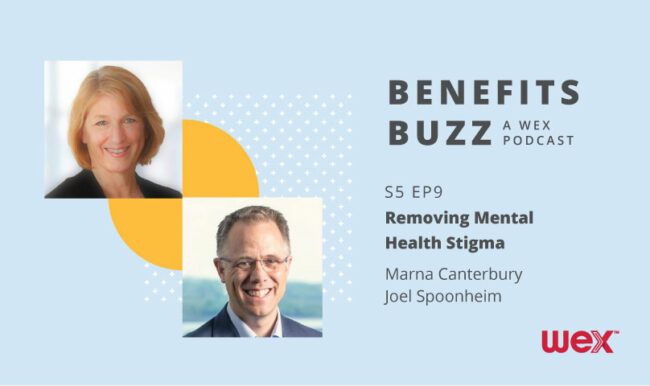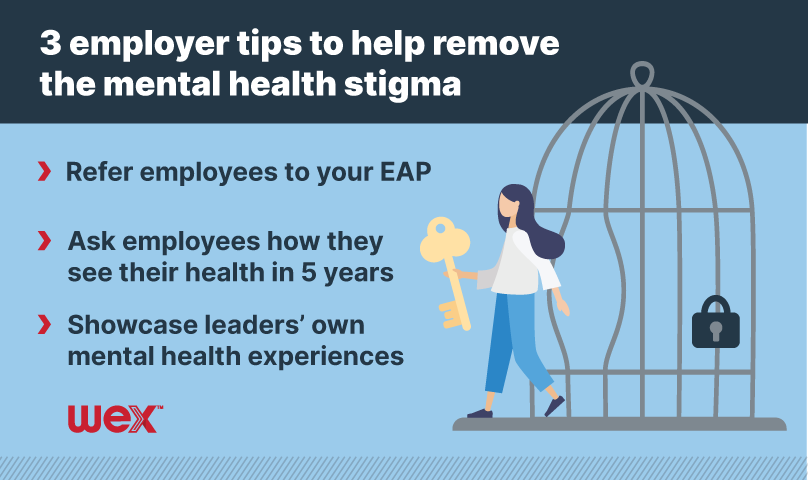Stay connected
Subscribe to our health benefits blog and follow us on social media to receive all our health benefits industry insights.

Since the start of the pandemic, mental and behavioral health requests increased 100 percent. For the youngest employees, that increase was even higher. While the mental wellness need was always there, employers are increasingly taking notice.
All of the above puts an increased emphasis on removing any barriers that discourage anyone from saying, “I need help.” What’s one of the biggest barriers? The stigma around mental health. As part of Mental Health Awareness Month, we chatted with a pair of experts from HealthPartners to learn tips on how to remove mental health stigma in the community and your workplace.
While most employers report that they are serious about their employees’ mental health, many haven’t confronted one critical challenge: stigma. Nearly 9 out of 10 people facing mental health challenges say that stigma and discrimination have a large and negative effect on their lives.
The problem with stigma is similar to the problem with other types of discrimination: People who do not match the majority tend to face additional challenges. “Stigma is about silence and stereotypes, it’s about a negative view of a human being because of a condition or a set of symptoms they’re experiencing. Stigma shows up as beliefs around mental illness not being very common or around believing that no one else has ever experienced what you’re experiencing” Marna Canterbury, senior director of community health & engagement at HealthPartners, said on our Benefits podcast. As a result of stigma, mental health conditions are often viewed and treated differently from other chronic conditions. Stigma affects everything from interpersonal interactions to organizational structures, including access to treatment and reimbursement for costs.
At a time when people are at their most vulnerable, stigma prevents them from reaching out for help and utilizing the proper resources.
The National Academy of Medicine defines three primary forms of stigma:
It is notable that organizations across the country have been providing and improving their mental health resources, especially their employee assistance programs (EAPs). EAPs are an effective way to support employees and help them identify and address their mental health struggles before they become a genuine obstacle to their quality of life and workplace performance.
“We’re seeing double to triple the number of people reaching out for counseling via EAPs,” Joel Spoonhiem, senior director of worksite health & population at HealthPartners, said on our Benefits podcast. “Employers are now offering up to 25 appointments to their employees through EAPs because they are aware there is an access issue across the country where there aren’t enough therapists available. EAPs are able to fill these gaps.”
Spoonheim said more people are also exploring digital cognitive behavioral therapy, a practical, short-term form of psychotherapy (also known as talk therapy). There are many people that, because of stigma, will never go see a therapist but are willing to explore these same services digitally without human interaction. Spoonhiem explained that “these digital programs have the same efficiencies as meeting with a therapist for 8 to 10 sessions.”
Organizations have also been seeing their claims go up. This is a good thing and indicates that people are seeking care and utilizing the resources available to them. People need to seek care in order to get better as soon as possible.
The understanding of supporting employee mental health is well established, but where do you start? First, recognize that nationally nearly one in five people face mental health issues. It is extremely important that we shift the perspective within the workplace to reduce stigma. Begin by normalizing the conversation around mental health and raising awareness about the available resources within your organization.
Spoonhiem recommends these three tips to employers:
Check out the Make it OK campaign to learn more about how you can start the conversation about mental health in your workplace and reduce the stigma.

The information in this blog post is for educational purposes only. It is not legal or tax advice. For legal or tax advice, you should consult your own counsel.
Subscribe to our health benefits blog and follow us on social media to receive all our health benefits industry insights.